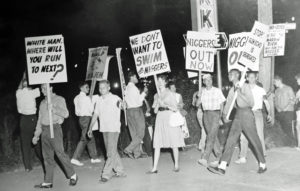Dion Diamond was always a prankster.
He used this fearlessness and humor to, as he put it, “crash segregated society.” A 1960 photo shows him sitting at a segregated lunch counter at the Drug Fair in Arlington’s Cherrydale neighborhood. He appears unbothered as the founder of the American Nazi Party confronts him.
“George Lincoln Rockwell, of the American Nazi Party, came in and surrounded us as we had the sit-in, and it was just amazing. I’m surprised that I didn’t panic. It’s amazing when you’re young and reckless. I call it youthful exuberance.”

Diamond is surprised as he looks at the picture today, noting that as a young man he didn’t fully understand the danger he was in. But the memory reinforces his belief in non-violence as a tactic for protest. A tactic that came naturally to him at a young age.
A Natural Born Leader
Diamond started staging sit-ins when he was only 15.
He grew up in Petersburg, Virginia., where everything was segregated, including the elementary school, high school, and even the state college. Diamond grew sick of looking at “whites only” signs and began his “own private sit-ins” at lunch counters, escaping through back doors when the police came.
“As I grew up, I don’t know how I really got involved, but I was involved in sit-ins before sit-ins became a named item. I would go into the local five and dime store and see the colored water fountain and the white water fountain. I would see the lunch counter that I wasn’t allowed to sit at, which I did. And of course, when the waitress or the counter person spoke to me and said, “You know, we can’t serve you,” I would continue to sit. And then she would call the manager.”
His parents were unaware of his activities, that is until a reporter called the house. They were proud of him, says Diamond, they just wished it would have been somebody else’s child.
Continuing the Fight for Civil Rights

He went on to become a student at Howard University. After reading about anti-segregation movements in Greensboro, North Carolina, he and a few other students organized a group called the Nonviolent Action Group (NAG). During the time, Washington D.C. was mostly desegregated, but the neighboring states were not.
“Back then, if you cross the Potomac River into Virginia, you’ve got segregation. If you cross the imaginary line, or the district line, into Maryland, Western Avenue, or Eastern Avenue, you’ve got segregation.”
The group crossed their first line in nearby Northern Virginia, where they staged their first sit-in at the Cherrydale lunch counter. After that success, the group moved onto the Glen Echo amusement park in Maryland, where its iconic Dentzel carousel, Spanish ballroom, and other amenities were closed to Black families. The group set up a picket line and picketed for the summer of 1960. Five students were arrested when they staged a sit-in on the carousel. Almost a year later, the park owners desegregated the park after pressure from then-Attorney General Robert F. Kennedy, Jr.
“Our salvation at the time was the cameramen. The newspaper reporters. We just thought that as long as they covered us, the word would get out and the pictures would get out just like the pictures of Rockwell over in Arlington, Alexandria … I just knew that I represented more than me, and if the picture got in the newspaper or on television of my hitting someone, whatever sympathies we might have had, or goodwill, would be down the tube, and literally down the tube.”
The following year, when the Freedom Rides were started by Fisk University student John Lewis and his colleagues, Diamond traveled with several other Howard University students to Montgomery, Alabama, and they continued the ride to Jackson, Mississippi.
“At any rate, when we arrived in Jackson and were immediately arrested, we were thrown into the Hinds County Jail. It was almost like a drunk tank. We were all there collectively, and we didn’t know that there were any other persons who would follow us. We just thought we were it. Then we were moved from the county jail a couple of days later to the county prison farm, and from the prison farm to the state penitentiary, and all the while not knowing that the buses were continuing to come into town and come into town.”
What was supposed to be a long weekend working with the Student Nonviolent Coordinating Committee (SNCC) ended up lasting over two years. He was arrested more than 30 times. It was not until 1963, when he enrolled at the University of Wisconsin, Madison, that he ended his activism in the civil rights movement. The young man who grew up in segregated Petersburg ultimately attended Harvard University, where he got a degree in education and went on to a career in finance. He continues to inspire today’s young people to speak up against racial inequality.

